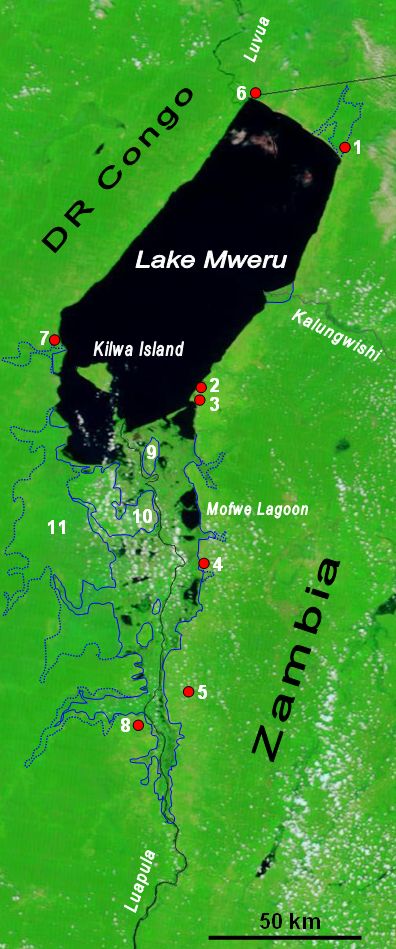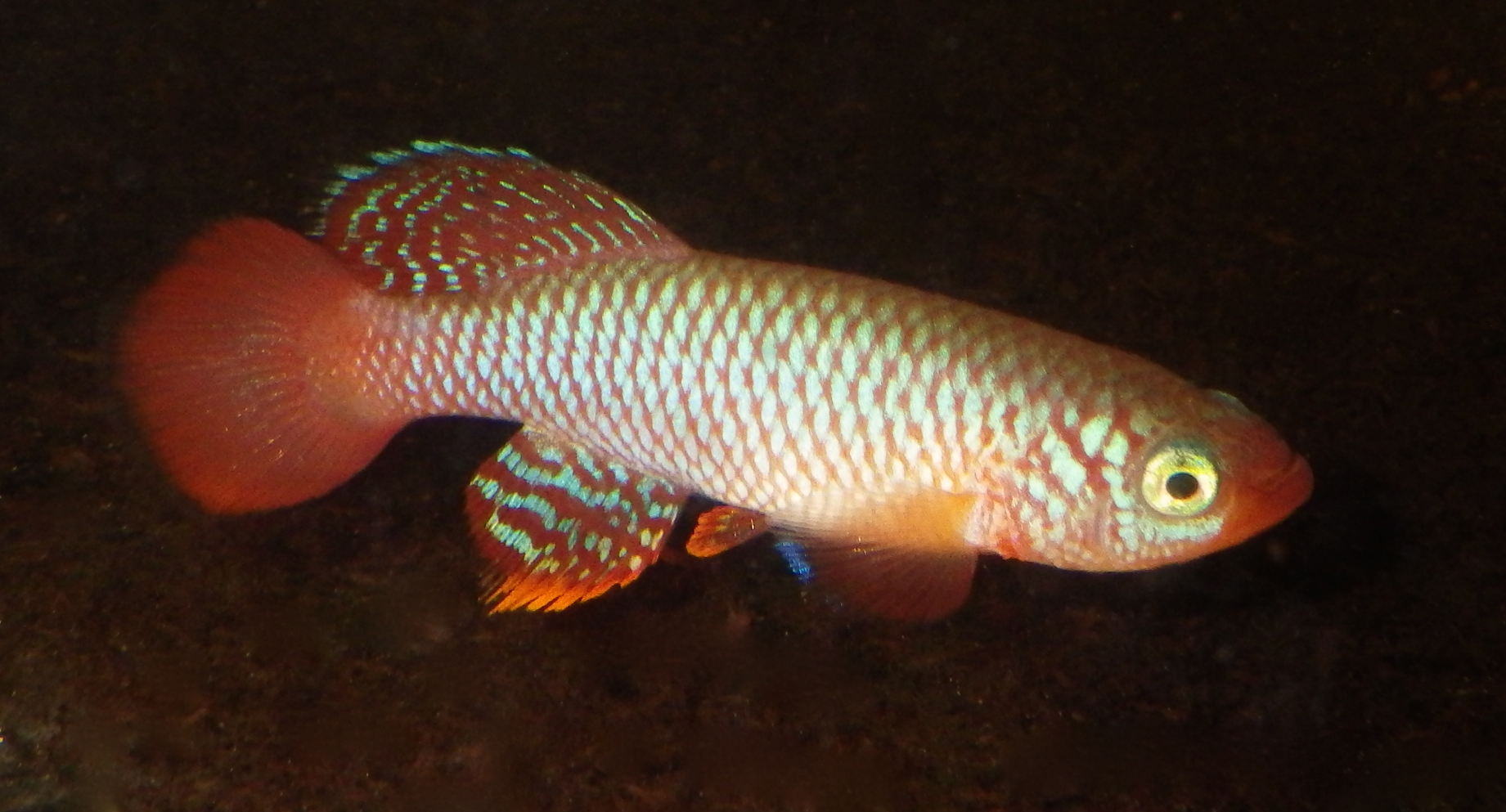|
Nothobranchius Milvertzi
''Nothobranchius milvertzi'' is a species of seasonal killifish in the family Nothobranchiidae. This species is endemic to northern Zambia. It is known only from the area of the type locality - ephemeral pools formed on the floodplain and in the seasonal riverbeds of the Lushiba Marsh in the Lake Mweru Lake Mweru (also spelled ''Mwelu'', ''Mwero'') is a freshwater lake on the longest arm of Africa's second-longest river, the Congo. Located on the border between Zambia and Democratic Republic of the Congo, it makes up of the total length of the ... basin, Luapula Province, northern Zambia. Nagy, B. (2014): ''Nothobranchius milvertzi'', a new species of killifish from the Lushiba Marsh in the Lake Mweru drainage, Zambia (Teleostei: Cyprinodontiformes: Nothobranchiidae). ''Ichthyological Exploration of Freshwaters'', 24 (4): 347-360. Sources Links ''Nothobranchius milvertzi''on WildNothos milvertzi Fish described in 2014 Fish of the Democratic Republic of the Congo ... [...More Info...] [...Related Items...] OR: [Wikipedia] [Google] [Baidu] |
Béla Nagy (ichthyologist)
Béla Nagy, a Hungarian independent researcher, specialized in the seasonal killifish genus ''Nothobranchius'', as well as members of the family Procatopodidae within the order Cyprinodontiformes. Taxon names authored * ''Lacustricola margaritatus'' , 2022Béla Nagy (ichthyologist), Nagy, B. & Watters, B.R. (2022) ''Lacustricola margaritatus'', a new species of lampeye from the Lake Victoria and Lake Kyoga basins in eastern Africa (Cyprinodontiformes: Procatopodidae). ''Zootaxa'', 5128 (1): 44–60. * ''Lacustricola nitidus'' , 2020Béla Nagy (ichthyologist), Nagy, B. & Chocha Manda, A. (2020) ''Lacustricola nitida'', a new species of lampeye from the upper Lualaba drainage, Democratic Republic of Congo (Teleostei: Cyprinodontiformes: Procatopodidae). '' Ichthyological Exploration of Freshwaters'', 30 (3): 201–211. * ''Lacustricola petnehazyi'' , 2018)Béla Nagy (ichthyologist), Nagy, B. & Vreven, E. (2018) ''Micropanchax petnehazyi'', a new species of lampeye cyprinodontifor ... [...More Info...] [...Related Items...] OR: [Wikipedia] [Google] [Baidu] |
Killifish
A killifish is any of various oviparous (egg-laying) cyprinodontiform fish (including families Aplocheilidae, Cyprinodontidae, Fundulidae, Profundulidae and Valenciidae). All together, there are 1,270 species of killifish, the biggest family being Rivulidae, containing more than 320 species. As an adaptation to living in ephemeral waters, the eggs of most killifish can survive periods of partial dehydration. Many of the species rely on such a diapause, since the eggs would not survive more than a few weeks if entirely submerged in water. The adults of some species, such as '' Kryptolebias marmoratus'', can additionally survive out of the water for several weeks. Most killies are small fish, from , with the largest species growing to just under . The word ''killifish'' is of uncertain origin, but is likely to have come from the Dutch ''kil'' for a kill (small stream). Although ''killifish'' is sometimes used as an English equivalent to the taxonomical term ''Cyprinodont ... [...More Info...] [...Related Items...] OR: [Wikipedia] [Google] [Baidu] |
Nothobranchiidae
Nothobranchiidae are a family of bony fishes containing roughly 300 species, also known as African rivulines. They are small killifish, usually measuring about . They are limited to Africa, living in fresh water but being also somewhat salt-tolerant. They are also found in muddy or brackish water. Some species are kept as aquarium pets. They have frilly fins and many are brightly colored. They were formerly included in the family Aplocheilidae (which was later limited to Malagasy, Seychellean and Asian species); a return to that broader family has recently been suggested.Costa, W.J.E.M. (2016)Comparative morphology and classification of South American cynopoeciline killifishes (Cyprinodontiformes: Aplocheilidae), with notes on family-group names used for aplocheiloids.''Vertebrate Zoology, 66 (2): 125-140.'' Members of genus ''Nothobranchius'' are found in mud pools on the plains of Africa, a habitat shared by no other fish except the lungfishes. Their life cycle is onl ... [...More Info...] [...Related Items...] OR: [Wikipedia] [Google] [Baidu] |
Endemism
Endemism is the state of a species being found in a single defined geographic location, such as an island, state, nation, country or other defined zone; organisms that are indigenous to a place are not endemic to it if they are also found elsewhere. For example, the Cape sugarbird is found exclusively in southwestern South Africa and is therefore said to be ''endemic'' to that particular part of the world. An endemic species can be also be referred to as an ''endemism'' or in scientific literature as an ''endemite''. For example ''Cytisus aeolicus'' is an endemite of the Italian flora. ''Adzharia renschi'' was once believed to be an endemite of the Caucasus, but it was later discovered to be a non-indigenous species from South America belonging to a different genus. The extreme opposite of an endemic species is one with a cosmopolitan distribution, having a global or widespread range. A rare alternative term for a species that is endemic is "precinctive", which applies t ... [...More Info...] [...Related Items...] OR: [Wikipedia] [Google] [Baidu] |
Zambia
Zambia (), officially the Republic of Zambia, is a landlocked country at the crossroads of Central, Southern and East Africa, although it is typically referred to as being in Southern Africa at its most central point. Its neighbours are the Democratic Republic of the Congo to the north, Tanzania to the northeast, Malawi to the east, Mozambique to the southeast, Zimbabwe and Botswana to the south, Namibia to the southwest, and Angola to the west. The capital city of Zambia is Lusaka, located in the south-central part of Zambia. The nation's population of around 19.5 million is concentrated mainly around Lusaka in the south and the Copperbelt Province to the north, the core economic hubs of the country. Originally inhabited by Khoisan peoples, the region was affected by the Bantu expansion of the thirteenth century. Following the arrival of European explorers in the eighteenth century, the British colonised the region into the British protectorates of Barotseland-No ... [...More Info...] [...Related Items...] OR: [Wikipedia] [Google] [Baidu] |
Lake Mweru
Lake Mweru (also spelled ''Mwelu'', ''Mwero'') is a freshwater lake on the longest arm of Africa's second-longest river, the Congo. Located on the border between Zambia and Democratic Republic of the Congo, it makes up of the total length of the Congo, lying between its Luapula River (upstream) and Luvua River (downstream) segments. Google Earth accessed 29 March 2007. When in flood Lake Bangweulu and its swamps may temporarily have a larger area, but not a larger volume. Mweru means 'lake' in a number of Bantu languages, so it is often referred to as just 'Mweru'.The '' Northern Rhodesia Journal'' online at NZRAM.org: J B W Anderson: "Kilwa Island and the Luapula." Vol II, No. 3 pp87–88 (1954) Physical geography Mweru is mainly fed by the Luapula River, which comes in through swamps from the south, and the Kalungwishi River from the east. At its north end the lake is drained by the Luvua River, which flows in a northwesterly direction to join the Lualaba River and then ... [...More Info...] [...Related Items...] OR: [Wikipedia] [Google] [Baidu] |
Luapula Province
Luapula Province is one of Zambia's ten provinces located in the northern part of the country. Luapula Province is named after the Luapula River and its capital is Mansa. As per the 2010 Zambian census, the Province had a population of 991,927, which accounted for 7.57 per cent of the total Zambian population. The province has an international border along Democratic Republic of the Congo (DR Congo) and domestically extends along the northern and eastern banks of the Luapula river from Lake Bangweulu to Lake Mweru. The province is inhabited by Bemba, who are also the major tribe in the country. Bemba is also the most spoken language in the province. The major economic activity is agriculture and fishing, with sweet potato being the major crop. Mutomboko ceremony is the most important festival celebrated. Lumangwe Falls, Mumbuluma Falls, Mumbotuta Waterfalls, Kundabwika Waterfalls and Chilongo Waterfalls are the major water falls. The chief artery of the province is the Sa ... [...More Info...] [...Related Items...] OR: [Wikipedia] [Google] [Baidu] |
Nothobranchius
''Nothobranchius'' is a genus of small, freshwater killifish, classified in either the family Nothobranchiidaevan der Laan, R., Eschmeyer, W.N. & Fricke, R. (2014)Family-group names of Recent fishes.''Zootaxa, 3882 (2): 1–230.'' or a more inclusive AplocheilidaeCosta, W.J.E.M. (2016)Comparative morphology and classification of South American cynopoeciline killifishes (Cyprinodontiformes: Aplocheilidae), with notes on family-group names used for aplocheiloids.''Vertebrate Zoology, 66 (2): 125-140.'' in the order Cyprinodontiformes. There are many species: as of 2018 there are more than 70 species, many with very small distributions. They are primarily native to East Africa from Sudan to northern South Africa, but half a dozen species are found in the upper Congo River Basin and two species ('' N. rubroreticulatus'' and '' N. thierryi'') are from west-central Africa; the greatest species richness is in Tanzania. ''Nothobranchius'' typically inhabit ephemeral pools that are fi ... [...More Info...] [...Related Items...] OR: [Wikipedia] [Google] [Baidu] |
Fish Described In 2014
Fish are aquatic, craniate, gill-bearing animals that lack limbs with digits. Included in this definition are the living hagfish, lampreys, and cartilaginous and bony fish as well as various extinct related groups. Approximately 95% of living fish species are ray-finned fish, belonging to the class Actinopterygii, with around 99% of those being teleosts. The earliest organisms that can be classified as fish were soft-bodied chordates that first appeared during the Cambrian period. Although they lacked a true spine, they possessed notochords which allowed them to be more agile than their invertebrate counterparts. Fish would continue to evolve through the Paleozoic era, diversifying into a wide variety of forms. Many fish of the Paleozoic developed external armor that protected them from predators. The first fish with jaws appeared in the Silurian period, after which many (such as sharks) became formidable marine predators rather than just the prey of arthropods ... [...More Info...] [...Related Items...] OR: [Wikipedia] [Google] [Baidu] |
.jpg)

.jpg)

